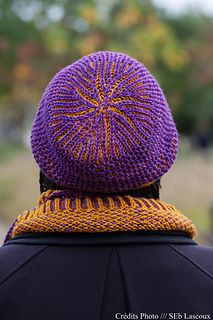patterns >  Pain Perdu (Full Set) and 1 more...
Pain Perdu (Full Set) and 1 more...
> Pain Perdu (Hat and Mitts)







Pain Perdu (Hat and Mitts)
Pain Perdu —so named because it is a fluffy, quick knit made up of brioche stitches—consists of a hat and mitten set. All of which have an attractive reverse side. The sizing is quite flexible and those provided fit a range from child to adult.
There are two brioche stitches used in this pattern: brioche two colour ribbing, and brioche honeycomb.
The pattern assumes you are an advanced beginner or intermediate knitter, and can be knit with two skeins of contrasting DK yarns. The range of colour combinations is boggling and entirely up to you :)
Pattern will include a Techniques PDF with short video how-tos and photo tutorials, which will be added shortly after publishing.
Currently the videos are available only in French. English videos soon to follow.
°°°
“ Pain Perdu ” est un ensemble de patrons qui vous permettra de tricoter un bonnet, et une paire de mitaines assortis complètement réversibles. Son nom est un clin d’oeil au point principalement utilisé pour réaliser cet ensemble: le point “brioche” (en anglais “brioche stitch” ) aussi appelé point alvéole. Les tailles proposées dans le patron conviendront à plusieurs statures.
2 sortes de points brioche sont utilisées : le point brioche “ nid d’abeille ” et les côtes brioches bicolores. Pour réaliser ces projets, vous devez connaître la technique du tricot en rond (avec des aiguilles circulaires) ainsi que les bases du crochet (maille chainette). Ce patron présuppose donc que vous soyez au moins d’un niveau intermédiaire.
Ce modèle gagne à être tricoté avec deux laines DK de couleurs contrastées. La variété des combinaisons possibles est extraordinaire.
Le patron inclut un PDF contenant des explications sur les techniques employées, et est accompagné d’une section “Techniques” qui contient un fichier PDF interactif, avec 3 courtes vidéos Pour visionner ces vidéos, vous devez utiliser Adobe Reader

70724 projects
stashed
54594 times
2784 projects
stashed
2361 times
147 projects
stashed
114 times
- First published: November 2013
- Page created: November 7, 2013
- Last updated: March 9, 2014 …
- visits in the last 24 hours
- visitors right now




